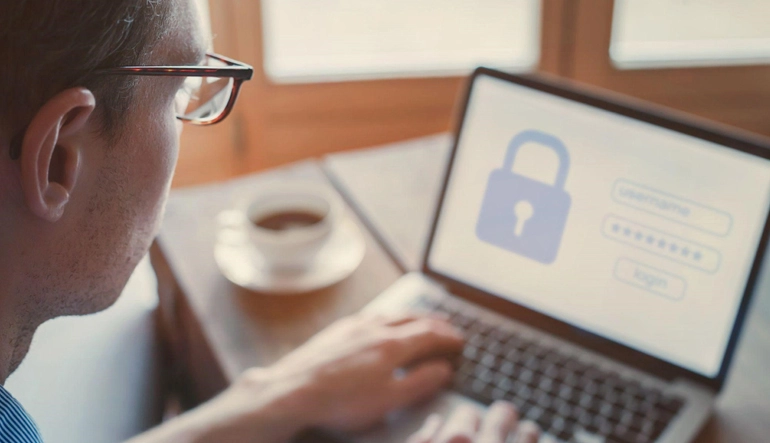
5 Simple Steps to Better Personal Cybersecurity
If you’re like most American consumers, a massive portion of your life takes place online. Email and social media platforms keep you connected, e-commerce sites keep you well supplied and dating apps can even help you find romance. Most financial institutions also offer an online platform, allowing you to check your balance and transfer funds with a swipe of a finger or a click of a mouse.But as the internet continues to expand, so do the threats of online scams. Here are five simple steps that you can take to fortify your personal cybersecurity.
1. Update Your Software
The older your software, the more vulnerable it is to malware and other forms of cyberattacks. You can prevent these dangers by keeping your operating system up-to-date with your programs and applications.Wherever possible, turn on automatic system updates for your electronic devices. For example, if your laptop runs Microsoft Windows, you can turn on automatic updates to keep your operating system and its security protocols up-to-date.
Depending on the device, you can also schedule an update during your “off” hours to stay safe without interrupting your workflow.
Similarly, make an effort to ensure your web browser stays updated, including any plugin programs that you may have installed.
Software developers are continually adapting to external cyber threats. By updating your software regularly, you’ll take advantage of security updates and other features that help you combat ransomware, viruses and other attacks that impact businesses and consumers.
2. Install Cybersecurity Software
The best step to protect yourself from viruses, malware and other online threats is installing cybersecurity software on your devices. Software from a trusted provider can offer strong protection against malicious attacks, and typically, these providers are continually updating the software to guard against newly discovered threats.If you use your personal device for work, don’t rely on your employer’s network security features or firewall. These features are helpful, but they won’t always deliver the protection you need for your device. Additionally, you can’t always count on your employer to use the most up-to-date software or security protections, which is why taking responsibility for your own cybersecurity is essential.
Keep your cybersecurity software up-to-date, as with the rest of your software. Keeping up with the latest updates can offer fuller protection of your devices and guard against new threats.
3. Implement Two-Factor Authentication
A strong password alone isn’t going to cut it. As a result, most consumers now rely on two-factor authentication to protect their devices and data.What is two-factor authentication? It’s a security protocol that typically relies on a username and password, but an additional step is required to verify the user’s identity. This second step can be anything from an additional security question, location data or even biometric data such as a fingerprint or facial recognition.
For example, you might use a banking app on your phone that relies on a password as well as your phone’s camera to recognize your face, or your bank might send a text message with a unique code that lets you log into your account after you enter your password.
The point of all of this is simple. Even if hackers were to gain access to your username and password, they wouldn’t be able to access your personal data or your accounts since they lack the personal information you put in place.
Whenever possible, rely on two-factor authentication to protect your most sensitive accounts, especially your bank or credit card data.
4. Learn to Spot Online Scams
Online scams are everywhere and usually show up in the form of an email or text message. Some can be surprisingly compelling — it’s not uncommon for scam artists to claim to represent a person of authority (e.g., an IRS agent) and convince you to contact them. They are often known to threaten penalties — even arrest — if you don’t comply.Don’t fall for it. Scam artists use these tactics to harvest your personal data and gain access to your devices and accounts.
How can you spot a scam? If you’re not sure who sent the message, don’t respond. Never click on any links or attachments from unknown senders, as they can contain malware that infects your computer. From there, contact the organization using their established procedures.
For instance, if someone contacts you claiming to be from your bank or credit card company, don’t reply. Instead, contact your bank through their primary customer service phone number or email. This way, you aren’t ignoring the problem and can feel more confident in deleting future messages from this confirmed scam artist.
5. Avoid Public Wi-Fi
Avoid using free Wi-Fi services whenever possible in public places, such as airports, shopping centers, hotels or conference centers. Hackers love to position themselves between you and the connection point, which is a perfect place to steal your data or even your identity.Decline to join public networks if your phone or device prompts you to do so. If you’re working from a public location, your phone’s wireless signal is generally strong enough to establish a connection for sending emails or using other important apps.
Most smartphones can also be turned into wireless hotspots. Activate this feature and connect your laptop to your phone’s private network rather than trusting the public Wi-Fi at a coffee shop or airport. Remember that different phone providers have different data usage policies, so keep track of your hotspot to avoid paying for additional data usage.
Protect Your Finances
Naturally, your personal finances are your most valuable pieces of data. Implementing these tips can provide a comprehensive approach to your personal cybersecurity and hopefully keep you free from hackers, scam artists and various forms of malicious software.Maintaining your personal cybersecurity is an ongoing effort as scams become more advanced and sophisticated. Explore our website to discover additional ways to protect yourself and safeguard your money while spending more time online.
Visit our Financial Knowledge Blog to learn more tips on setting up a solid financial future, ask your employer about setting up a special workshop for you and your coworkers, or join us for Financial Wellness Wednesdays.



